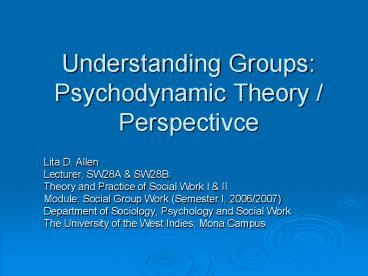Understanding Groups: Psychodynamic Theory Perspectivce - PowerPoint PPT Presentation
1 / 24
Title:
Understanding Groups: Psychodynamic Theory Perspectivce
Description:
Psychodynamic Theory. Key Concepts. Conscious, pre-conscious, ... Psychodynamic Theory. Anxieties in a group ... Psychodynamic Theory. Goal of the Analytic Group ... – PowerPoint PPT presentation
Number of Views:731
Avg rating:3.0/5.0
Title: Understanding Groups: Psychodynamic Theory Perspectivce
1
Understanding Groups Psychodynamic Theory /
Perspectivce
- Lita D. Allen
- Lecturer, SW28A SW28B
- Theory and Practice of Social Work I II
- Module Social Group Work (Semester I, 2006/2007)
- Department of Sociology, Psychology and Social
Work - The University of the West Indies, Mona Campus
2
Contrasting Perspectives Areas of Focus
- Insight vs Action
- Rational vs Affective
- Past vs Present / Future
- Individual vs Group
- Process vs Outcome
- Leader-centred vs Member-centred
3
Psychodynamic TheoryAreas of Focus
- Insight vs Action
- Rational vs Affective
- Past vs Present / Future
- Individual vs Group
- Process vs Outcome
- Leader-centered vs Member-centered
4
Psychodynamic TheoryView of human nature
- A deterministic view shaped by
- irrational and unconscious forces
- aggressive and sexual instincts
- repressed childhood conflicts
5
Psychodynamic TheoryKey Concepts
- Conscious, pre-conscious, unconscious
- Personality structure id, ego, superego
- Anxiety
- Ego defence mechanisms
- Resistance the defence of the defence
6
Psychodynamic TheoryKey Concepts
- Catharsis / Ventilation
- Insight and self-understanding
- Transference
- Countertransference
7
Psychodynamic TheoryGroup Dynamics
- Human behaviour (individually and in groups)
- influenced (determined) by
- irrational and unconscious forces
- aggressive and sexual instincts
- repressed childhood conflicts (between id, ego
and superego) - We develop ego defences to control anxiety
8
Psychodynamic TheoryDefence Mechanisms
- Denial
- Displacement
- Repression
- Regression
- Rationalization
- Reaction-formation
9
Psychodynamic TheoryEgo defence mechanisms
- Projection
- Avoidance
- Intellectualization / Identification
- Fantasy
- Emotional Insulation
- Sublimation
10
Psychodynamic TheoryAnxieties in a group
- Apprehension before joining
- Fear of participating in the group process
- Apprehension re leaving group
- Doubts about benefiting from group
- Fear of invasion of privacy
- Fear of giving up neurotic trends
11
Psychodynamic TheoryAnxieties in a group
- Fear of meeting again ones original family in
the group - Anxiety about the freedom that a group offers,
including the freedom to discuss anxiety - Etc.
12
Psychodynamic TheoryExamples of Resistances
- Arriving late or not showing up
- Intellectualizing
- Showing distrust
- Behaving uncooperatively
- Hiding behind a wall of silence or talking
incessantly - Lengthy life stories to avoid facing the present
13
Psychodynamic TheoryExamples of Resistances
- Maintaining attitude of complacency or
indifference - Watch others and refuse to participate
- Analyze other group members
- Go blank when asked to free associate about
other group members - Exhibiting an exaggerated need to help others in
the group - Acting out behaviours
- Using the group for mere socializing
14
Psychodynamic TheoryHow the individual functions
- Behaviours of individuals influenced by
- Distrust
- Anxieties
- Fears
- Insecurities
- Ego defences
- Resistance
- Prepared reactions
15
Psychodynamic TheoryHow groups function
- Re-create the family of origin (symbolically)
- Provide context for observing defensive
behaviours - Give feedback for increasing self-awareness
- Enabling catharsis
- Dealing with anxieties and resistances
- Working through transference and
countertransference - Understanding the present through insight to past
influences
16
Psychodynamic TheoryHow the leader functions
- Projection of feelings unto leader / therapist
- Guide analysis and interpretation of the
transference to influence insight and personality
change. - An enabler
17
Psychodynamic TheoryTechniques
- Identify stage of growth
- Allow catharsis
- Free association via free floating discussion
- Dream work analysis
- Working through the past, resistances,
transference, countertransference to achieve
interpretation and insight - Hypnosis
18
Psychodynamic TheoryHow to deal with resistances
- Enlist cooperation of group members
- Address feelings and concerns
- Give feedback about current, observable
behaviours - Do not label or censure
- Resistance should first be acknowledged by the
member
19
Psychodynamic TheoryHow to deal with resistances
- Worker and member should agree to work together
to work through the resistance - Establish a clear understanding that both are
working towards the same goal - Contract for bringing other group members into
the analysis of individual members resistances
20
Psychodynamic TheoryWhat will enable behaviour
change?
- Working with a group that
- symbolizes the original family
- gives on target feedback
- commits to stay with the process
- has a leader who is trained in the techniques
21
Psychodynamic TheoryGoal of the Analytic Group
- Restructuring of character and personality system
- Making unconscious conflicts conscious
- Provide context for symbolic re-enacting of
family of origin via the group
22
Psychodynamic TheoryAdvantages
- Increases self-awareness and self-understanding
- Provides a safe and non-threatening context for
the analytic process - Increases self-confidence and self-esteem by
working through anxieties, defences and
resistances.
23
Psychodynamic TheoryDisadvantages/Limitations
- Length
- Cost
- Verbal vs non-verbal clients
- Crisis oriented situations
- How appropriate for the poor, oppressed and the
disadvantaged - Acceptance of concepts in relation to personal
values and beliefs systems
24
Psychodynamic Theory
- What are the implications for the
- practice of social group work within
- the Caribbean context?































